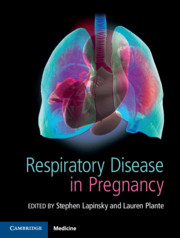Book contents
- Respiratory Disease in Pregnancy
- Respiratory Disease in Pregnancy
- Copyright page
- Contents
- Contributors
- Section 1 The Basics: for the Obstetrician
- Section 2 The Basics: for the Non-Obstetrician
- Section 3 Pulmonary Conditions Not Specific to Pregnancy
- 6 Pulmonary Infections in Pregnancy
- 7 Asthma in Pregnancy
- 8 Cystic Fibrosis in Pregnancy
- 9 Restrictive Lung Disease in Pregnancy
- 10 Thromboembolic Disease in Pregnancy
- 11 Pulmonary Hypertension and Pregnancy
- 12 Sickle Chest Syndromes in Pregnancy
- 13 Sleep-disordered Breathing in Pregnancy
- 14 Acute Respiratory Distress Syndrome in Pregnancy
- 15 Other Pulmonary Conditions in Pregnancy: Pleural Disease, Haemoptysis and Air Embolism
- Section 4 Pulmonary Conditions Related to Pregnancy
- Section 5 Other Pulmonary Issues in Pregnancy
- Index
- References
14 - Acute Respiratory Distress Syndrome in Pregnancy
from Section 3 - Pulmonary Conditions Not Specific to Pregnancy
Published online by Cambridge University Press: 14 April 2020
- Respiratory Disease in Pregnancy
- Respiratory Disease in Pregnancy
- Copyright page
- Contents
- Contributors
- Section 1 The Basics: for the Obstetrician
- Section 2 The Basics: for the Non-Obstetrician
- Section 3 Pulmonary Conditions Not Specific to Pregnancy
- 6 Pulmonary Infections in Pregnancy
- 7 Asthma in Pregnancy
- 8 Cystic Fibrosis in Pregnancy
- 9 Restrictive Lung Disease in Pregnancy
- 10 Thromboembolic Disease in Pregnancy
- 11 Pulmonary Hypertension and Pregnancy
- 12 Sickle Chest Syndromes in Pregnancy
- 13 Sleep-disordered Breathing in Pregnancy
- 14 Acute Respiratory Distress Syndrome in Pregnancy
- 15 Other Pulmonary Conditions in Pregnancy: Pleural Disease, Haemoptysis and Air Embolism
- Section 4 Pulmonary Conditions Related to Pregnancy
- Section 5 Other Pulmonary Issues in Pregnancy
- Index
- References
Summary
Acute respiratory failure is a rare occurrence during pregnancy, estimated to occur in 0.2–0.3% of pregnancies, but when this occurs it can have significant consequences for mother and child. Acute hypoxic respiratory failure associated with pregnancy requires attention to the inciting cause and distinction between cardiogenic and non-cardiogenic aetiologies. Specifically, acute respiratory distress syndrome (ARDS) is characterized by rapid onset of hypoxaemic respiratory failure associated with diffuse pulmonary opacities related to non-cardiogenic pulmonary oedema.
- Type
- Chapter
- Information
- Respiratory Disease in Pregnancy , pp. 139 - 147Publisher: Cambridge University PressPrint publication year: 2020



